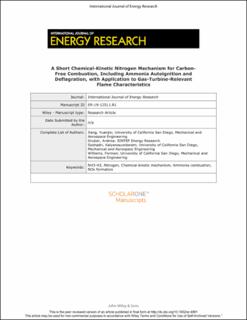| dc.description.abstract | Chemical‐kinetic combustion mechanisms for hydrogen‐oxygen‐nitrogen systems, motivated originally by concerns about NOx emissions during hydrogen burning, have recently acquired renewed interest as a result of the possibility of employing ammonia‐hydrogen mixtures in gas turbines and reciprocating engines as drop‐in fuel to replace the use of natural gas. Specifically, this is of relevance to the implementation of engineering approaches for economical power generation with carbon sequestration or to large‐scale energy‐storage schemes, based on hydrogen or efficient hydrogen carriers such as ammonia. Because computational investigations are facilitated by short mechanisms (since the use of large mechanisms is often prohibitively expensive in reactive flow simulations), in response to the original concerns, a short nitrogen mechanism was developed in San Diego in the 1990s (not updated since 2004), without consideration of ammonia combustion. In view of the renewed interest in this topic, that mechanism has now been expanded to encompass 60 elementary steps among 19 reactive chemical species, including ammonia burning and NOx production, as reported herein, greatly improving predictions. With particular attention to high reactant temperatures and high‐pressure conditions, relevant to industrial applications, it is shown that the present short mechanism retains satisfactory accuracy, exhibiting deviations that in most cases are within acceptable bounds (±20%). The revisions maintain the shortness of the original mechanism, adding only one more reactive species and six more elementary steps (while updating values of rate parameters of nine other steps, on the basis of newly available information). In addition, the short mechanism is applied herein to the analysis of fundamental combustion properties of ammonia/hydrogen/nitrogen‐air laminar premixed flames, at unstrained and strained conditions, for comparison with methane‐air flames as a reference gas‐turbine fuel. It is found by comparing carbon‐free and hydrocarbon laminar flames that these reactive mixtures, even if characterized by nearly identical adiabatic flame temperature and laminar flame speeds, nevertheless exhibit substantially different resistance to strain, with the ammonia/hydrogen flames exceeding the strain limit of methane flames by a factor of 5. | en_US |

